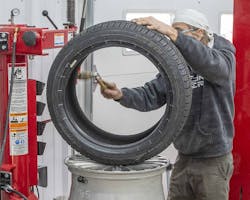Mounting and balancing tires correctly is the heart and soul of what tire dealers and other tire retailers do. And that means it’s absolutely critical the job is done with precision and delicacy.
The need for that extra attention is especially true when handling high performance tires and specialty wheels. We turned to the mounting and balancing equipment experts for tips on how to do the job right and what to avoid.
Representatives from Base USA Corp (Accu-Turn), Cemb USA, Hennessy Industries Inc., Hunter Engineering Co. and Snap-on Inc. offered tips on common mounting and balancing mistakes to avoid.
Chuck McCourt, president of Base USA Corp (Accu-Turn), says that when mounting a tire, “you must keep the bead in the drop center for the complete process to avoid damage to the tire or wheel. When mounting or demounting, always use a good rubber lube or paste — not soapy water.”
Mistakes to avoid
Here are several common mounting mistakes to avoid, according to Randy Gable, product manager, Cemb USA:
Using too much or too little lubrication. “Use a lubrication product that is vegetable oil-based with a short shelf life, applied with a brush,” he says.
“Lubricate the rim barrel, rim drop center balcony edge and bead toe edge area. Avoid rim bead seats and tire beads.”
Failure to confirm the wheel is centered. “Some very wide wheels and larger light truck wheels may require spacers and larger cones to be front cone-mounted.”
Failure to address radial force vectoring eccentricity. When using a wheel balancer with eccentricity (non-uniformity) measurement capability, check eccentricity and minimize, if needed. Mark the high spot of the assembly, remove the assembly, loosen the beads, lubricate the tire, rotate 180 degrees, reinflate and measure again.
Random wheel-to-vehicle hub mounting. “Once the assembly is off the balancer, placing the assembly back on the vehicle hub with the high point is another opportunity for improving ride quality.”
Kyle Harris, product manager, Hennessy Industries Inc., says the following mistakes should be avoided:
- Skipping the inspection. “Performing a good inspection of the wheel and tire is critical to success,” says Harris. “First, we need to determine if the tire being mounted is the correct size for the wheel we are trying to mount it on. We next need to inspect the tire carefully to be certain no safety issues exist that could cause a technician to be injured. Some of these things could be a bent or damaged wheel or a damaged bead on a tire that could make the assembly unsafe to inflate. We also need to determine what side of the wheel the drop center is on. This will tell us if we need to mount the tire with the wheel upside down or not.”
- Using dirty equipment. Having equipment that is in good service condition is critical to mounting a tire on a wheel without damaging the rim or the tire. “Tire machines that are dirty and covered with dirt and sand can damage a wheel with a delicate coating before you even get started,” notes Harris. “Making sure the machine is clean and free of any abrasive materials from previous tire changes can go a long way.” Also ensure that plastic inserts and jaw covers are clean. “Even often-overlooked items like a clean lube brush and fresh, clean mounting paste can make a huge difference when trying to mount a tough tire. All of these small details really do add up quickly.”
- Skipping settings. “Once we begin mounting, we need to be certain the machine is adjusted properly for the diameter and width of the wheel,” he says. “Be sure that the off-set on the mounting head is set properly and that the head itself is clocked properly to position the head, as well as the tail of the duck head, at the correct angle relative to the wheel. Next we need to make sure the depth is set properly to accommodate raised spokes or any other cosmetic features this specific wheel could have.”
- Using the wrong accessories. Having the correct accessories and using them properly can mean the difference between a successful job and an unsuccessful job.
- Not finding the true center. “Centering is paramount,” says Harris. “A wheel that is not centered either on the car or on the balancer will never ride properly. When a wheel is removed from a vehicle, the hub bore center of the wheel can sometimes have corrosion, especially in winter climates. A quick cleaning of the hub face on the vehicle and the hub bore center on the wheel will pay dividends.” A wheel lift can help with centering on heavy vehicles. “Another great addition to help center a wheel is using a set of pin plates to make sure the wheel mates to the collet evenly.“
- Incorrect wheel weight placement. Placing weights in the correct position and using the correct size can help technicians be sure they get it right the first time. “A balancer that has a method of identifying residual static is a great tool for technicians to be sure any remaining static forces are taken care of while the wheel is still on the shaft of the balancer.”
- Not finishing the job well. Placing the clean, balanced wheel and tire assembly back on a clean vehicle hub and then properly torquing everything to the proper specification “ensures the job is done correctly.”
What you should do
Jim Hudson, tire changer product manager, Hunter Engineering Co., says using the right equipment for the job is critical.
“Premium tires and wheels need premium equipment to service them properly.
“Features like center clamping, leverless heads, roller bead breakers and press assist devices make it easier on the technician and the tire. Also make sure things like mount head inserts, if equipped, and other plastic protections are in place.”
Proper lubrication is important. “Lubricating the beads during or after bead breaking is important to relieve demounting stress on the tire, as is lubricating the beads before mounting.”
Pay attention to staggered sizes. ”Many high performance tires are directional” and some vehicles “have staggered sizes,” says Hudson.
“Pay attention to these things, especially when changing sets of tires, to prevent doing the same work twice.”
And speed “is never your friend when servicing expensive and challenging assemblies.
“Slower movements, bead lubrication and flange plate usage take only a few extra minutes, but can save hundreds on a single damage claim. Spot potential risks and avoid them by simply getting out of the flat-rate mentality.”
Leandro Camargo, product manager for John Bean from Snap-on Inc., agrees that speed is not of the essence when mounting high performance and ultra-high performance tires on expensive custom wheels.
“Please slow down and take your time,” he says. “Think of it this way — as the price of the wheel goes up, so does the amount of time to change it.”
Here are some other tips to ensure successful mounting and balancing:
- To properly use bead assist tools, make sure the tire is in the drop center of the rim. “You will rip or tear up the tire if you get out of the drop center of the rim,” notes Camargo.
- On a rim clamp tire changer, clamp the wheel from the outside. Make sure you have a plastic protector on the clamping jaws to avoid marking up the rim.
- Ensure the tire pressure monitoring system (TPMS) sensor is in its proper place to prevent damage during the process and “when loosening the bead, ensure the TPMS sensor is at six o’clock to 12 o’clock to prevent damage.”
- Check that the mount/demount head has proper plastic protectors in place to prevent metal-to-metal contact.
- Use ample amounts of commercial-grade tire paste when mounting and demounting and “apply paste to the bead of the tire and also the rim seat area.”
On a center post tire changer, when changing a reverse drop center wheel, “one must have a reverse drop center adapter to prevent damage to the face of the wheel. When using a rim clamp tire changer, one must unclamp the wheel before inflating the tire. The bead must be seated before inflating to 40 psi. If the bead isn’t seated, the tire and wheel assembly needs to be placed into a safety cage to safely seat the bead.
“To mount plastic-clad wheels on a center post tire changer properly, you must use a reverse drop center adapter to mount the tire,” says Camargo.



